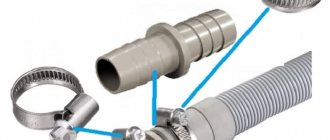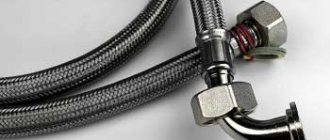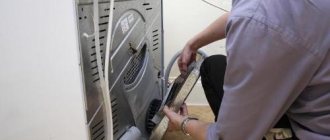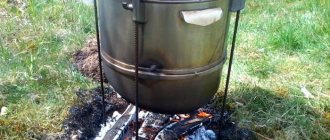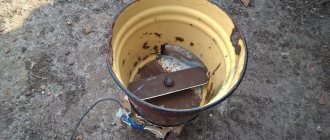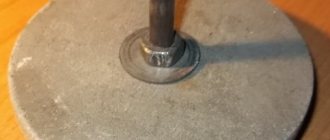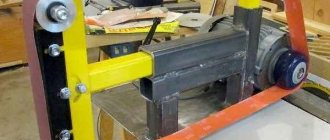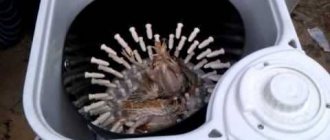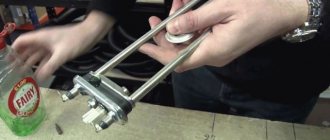Before we talk about connecting the washing machine motor, you need to understand what it is. Perhaps someone has known the wiring diagram for the electric motor of a washing machine for a long time, while others are hearing it for the first time.
An electric engine is a machine powered by electricity that serves as a drive for various mechanisms, i.e. setting them in motion. They produce asynchronous and synchronous units.
Synchronous motors
It has been known since school days that when magnets are brought close, they attract or repel. The first case occurs at opposite magnetic poles, the second - at like ones. We are talking about permanent magnets and the magnetic field they constantly create.
In addition to those described, there are variable magnets. Everyone remembers an example from a physics textbook: the picture shows a magnet in the shape of a horseshoe. Between its poles there is a frame made in the shape of a horseshoe and having half rings. Current was supplied to a horizontally located frame.
Since the magnet repels like poles and attracts unlike poles, an electromagnetic field arises around this frame, which turns it vertically. As a result, it receives a current that is opposite in sign to the first case. The changing polarity rotates the frame and returns it to the horizontal plane.
The operation of a synchronous electric motor is based on this principle.
In a real circuit, current is supplied to the windings of the rotor, which is a frame. The source that creates the electromagnetic field is the windings. The stator performs the functions of a magnet.
It is also made of windings or a set of permanent magnets.
The rotor speed of the electric motor of the described type is the same as the current supplied to the winding terminals, i.e. they work synchronously, which gives the electric motor its name.
Existing types of electric motors
Modern washing machines are equipped, as a rule, with single-phase electric motors with tachogenerators that regulate the speed. Soviet-era electric motors are already considered a rarity; they are distinguished by a two-speed operating mode. Motors installed in modern washing machines can be divided into three types - these are motors:
- asynchronous;
- collector;
- inverter
Asynchronous
For motors of this type, the rotor speed differs from the speed of the magnetic field of the stator winding. This is the most common type of electric motor. Washing machines are equipped with asynchronous capacitor motors, powered from a single-phase household electrical network.
The stator has two windings, one of which is connected directly to the network, and the second winding is connected to a starting capacitor, forming a starting rotating magnetic field.
The advantage of asynchronous engines is their simplicity of design and ease of maintenance. Wear-resistant electric motors can last for decades if properly maintained.
The disadvantages of asynchronous motors include sensitivity to fluctuations in the frequency of the mains current and the inability to change the shaft rotation speed during operation, but this does not prevent them from being used in various home-made devices.
Collector
Many washing machines today are equipped with commutator motors. A distinctive feature is the presence of 2 brushes. The brushes are adjacent to the rotor commutator, imparting electricity to it, which causes the rotor to rotate in the magnetic field of the stator winding. Collector power units operate using a belt transmission of torque.
The advantages include the presence of a pulley on the motor shaft, which makes it easier for home craftsmen to create devices with a belt drive, and the ability to operate on direct current. As a rule, motors are small in size and controlled by a simple electrical circuit.
The disadvantage is the rapid wear of the belt and the “ability” of the brushes to fail at the most unexpected moment. Still, these can be considered minor trifles compared to the benefits.
Inverter
For the first time, an inverter motor was installed in a washing machine by LG in 2005. Since then, inverter-type motors have been widely used by leading companies in household washing machines. Unlike its analogues, the inverter is attached directly to the drum of the machine and does not require a belt drive or bearings.
The advantages of a direct drive inverter are simplicity of design, compactness, the ability to assign different operating modes, low noise and high efficiency due to the absence of loads from belt drive friction.
The downside is the impracticality of repairs in the event of an electric motor failure. The cost of restoration may be greater than the value of the engine itself. Also considered a disadvantage is the impossibility of use in various home-made machines and mechanical devices due to the design features of inverters.
How does an asynchronous motor work?
To understand the principle of its operation, we recall the same picture as in the previous example: a frame (but without half rings) is placed between the magnetic poles. The magnet is made in the shape of a horseshoe, the ends of which are connected.
We begin to slowly rotate it around the frame, watching what is happening: until a certain moment, no movement of the frame is observed. Then, at a certain angle of rotation of the magnet, it begins to rotate behind it at a speed less than the speed of the latter. They work asynchronously, which is why the motors are called asynchronous.
In a real electric motor, a magnet is a winding placed in the stator slots to which current is supplied. The rotor is a frame. In its grooves there are short-connected plates. That's what they call it - short-circuited.
How to extend the life of the motor: operating tips
- It is very easy to extend the life of the motor if you follow simple steps:
- Connect the network only when you are going to wash it, and then unplug it from the outlet;
- Use a grounded outlet;
- If extension cords are needed, make the connection at least 16A;
- If possible, do not turn on maximum speed;
- The load on the washing drum is not 100%. If it’s 5 kg, then I’ll put 5 kg in there, but remember that you need 5 kg of wet things, or even better if you load 4;
- Listen while you work. This way you can determine before a breakdown occurs;
- Prevention of mud deposits and scale. The easier it is to turn, the better for the motor;
- Make sure that the engine is always dry and there is as little moisture nearby as possible;
Based on the above, the golden rule emerges - stick to a gentle regime and you will not have to look for a way to repair, connect or buy a new washing machine.
Advantages of asynchronous motors for washing machines
The electric motor that rotates the drum is the heart of the washing machine. The drive in the very first versions of the machines was belts that rotated the container with laundry.
But today the asynchronous unit, which converts electricity into mechanical energy, has been significantly improved.
Most often, washing machine circuits contain asynchronous electric motors, consisting of a stator, which does not move and serves as both a magnetic circuit and a supporting structure, and a moving rotor that rotates the drum. An asynchronous motor operates due to the interaction of the magnetic alternating fields of these nodes.
We recommend:
- Connection diagram for solar panels of a country house
- Unusual skateboards that move themselves
- Assemble a solar battery with your own hands
Asynchronous motors are divided into two-phase, rare, and three-phase.
The advantages of asynchronous units include:
- simple design;
- simple maintenance, including replacement of worn bearings and
- periodic lubrication of the electric motor;
- silent operation;
- relative cheapness.
- Of course, there are also disadvantages:
- low efficiency;
- big sizes;
- low power.
Such motors are usually installed on inexpensive models.
Speed adjustment
Automatic washing machines make adjustments at the software level, but if you need to inexpensively and simply lower the speed of the washing machine and there are no requirements for power loss, it is best to use a dimmer or if you have a rheostat of the required power from the times of the USSR.
If it is important to maintain speed and power under load, additional electrical circuits must be used. The finished version may be based on the TDA1085 integrated circuit
Dimmer control of light.
When the washing machine runs on a commutator motor, the speed changes very simply by changing the current passing through the winding. Again, just remembering Ohm's law (I = U*R), you need to change the voltage - through cutting off part of the phase - and we get a Pulse-Phase Control System (PPCS). Connecting it, of course, will reduce the power of the washing machine motor, including the automatic one. If such things are not very critical for us, then we make the connection.
In everyday life, to quickly adjust the motor from the washing machine, you can connect a dimmer with a sufficient power reserve (up to 3 kW). Dimmers are often used to adjust lighting. The weak point in the dimmer will be the triac that needs to be changed to (BTA20-00BW), or the one you have (at least *7 reserve is needed, or better yet *10) depending on the power of the motor, but all this is necessary if the dimmer is not enough . The dimmer is connected in series as shown in the diagram
Connection diagram
Features that need to be taken into account to connect the electric motor from the washing machine to a 220 V network:
- the connection diagram demonstrates that the motor operates without a starting winding;
- There is also no starting capacitor in the connection diagram - it is not required for starting. But it is necessary to connect the wires to the network strictly in accordance with the diagram.
This video will help you figure it out:
Video: How to connect a motor from a washing machine to 220
The main thing is to connect strictly in accordance with the wire connection diagram.
No wires (2 white) are needed to connect – engine speed meter. The others are the red and brown wires (3 and 4) going to the stator, as well as the gray and green (1 and 2) going to the brushes, as can be seen from the connection diagram and must be connected correctly.
In the motor connection diagram, the stator windings are connected in series.
220V is connected to the red wire of the winding, as indicated in the connection diagram. One brush is connected to the end of the next winding.
The other, as required by the connection diagram, is connected to 220 V. The engine is ready for operation, but it rotates in one direction. To turn it in the opposite direction, you need to swap the brushes.
How to adjust rotation
There are many ways to control speed:
- laboratory autotransformer;
- adjustment board for household appliances;
- screwdriver buttons, grinders;
- lighting regulators (switches, toggle switches).
The adjustment scheme is simple, you can do it yourself.
This is a satisfactory option for a pump or fan. For more powerful mechanisms (for example, machine tools), a different regulator circuit will be needed.
Read also: What are three calms
The essence of the question is how to reduce speed without losing performance? The connection is made through a tachogenerator, which transmits the number of turns to the speed controller microcircuit, which coordinates the cycle using a thyristor.
Such a board allows you to either increase or decrease the speed, but requires constant, intensive cooling due to overheating. A detailed video about how the speed and power of the stroke are regulated by connecting to the microcircuit can be viewed here:
Now you know what speed different types of engines make and how to set up this process in your home workshop. Good luck!
Washing machines, like any household appliance, tend to break down. And it’s good if the breakdown can be corrected at low financial cost. But alas, there are times when there is no point in repairing a washing machine, since it is easier and cheaper to buy a new unit. But what to do with the old one? Moreover, if its engine is in excellent condition and continues to work properly.
Speed control relay
Motor connection diagram in an old washing machine
Everything is more serious here. You need to find 2 pairs of pins that match each other using a multimeter (toaster). To do this, fix the device on any of the terminals and find the paired one using a probe. The two remaining pins will be the second pair automatically.
Now determine the location of the working and starting windings by measuring the resistance. The starting point (PO), which creates the starting torque, is found by its higher resistance. The disturbance winding (OB) creates a magnetic field.
Theory of operation of a 220 V electric motor
Asynchronous motors for single-phase networks are mainly motors with two-phase windings and an auxiliary phase taken from a capacitor. Such motors are used in household appliances. A similar motor is used, in particular, to drive a washing machine. In addition to two-phase winding motors, three-phase winding motors are sometimes used in some other household appliances.
During direct starting, the motor can receive a current from the network that significantly exceeds its rated value. This current is called the motor starting current, and its value varies in the region Ir = 5-7In .
One way to reduce the inrush current is to use a star-delta switch. A motor designed to operate the stator in a triangular connection at a given mains voltage is connected to the star system at the time of start-up:
Read also: Device for measuring internal diameter
Due to the reduced voltage supplied to the stator winding phase and the change in connections from delta to star, the current taken from the network will be reduced by three times compared to the starting current in a delta circuit. However, when connected to a star, the motor has three times less starting torque, which makes it impossible to use this method during heavy starting (with a heavy load).
Connecting the electric motor from a new washing machine
If you look at the terminal block with the wires on the front, usually the first two wires on the left are the tach wires, which measure and regulate the rotation speed of the washing machine motor. We don’t need them - they are crossed out with a cross.
Read also: Grinding disc for concrete for grinder 125
In different models of washing machines, the wires differ in color, but the connection principle remains the same. You just need to find the necessary wires by testing them with a multimeter.
A working tachogenerator in a quiet state usually has a resistance of 50-100 Ohms. You will immediately find these wires and disconnect them.
If you need to change the engine speed in the opposite direction, simply drag the jumper to the other pins. Look at the diagrams to see what it looks like.
Two contacts go through the brushes to the rotor windings, and the other two contacts go to the stator winding. The remaining contacts are a sensor for measuring the motor rotation speed. The rotor and stator windings are connected in series and by changing the ends of one of the windings, you change the direction of rotation. Without an electronic regulator, the engine will accelerate to several thousand revolutions per minute (as at maximum spin).
A neighbor in the building placed an automatic washing machine on the landing for further disposal, as a repairman told him, the motor was damaged. Not one Samodelkin, never in his life, will pass by a discarded unit without picking it up for spare parts or at least looking inside at the contents. I have the same problem, so I decided to spare my neighbor the hard physical work of taking the unit to the trash and took it to my village for spare parts.
In the photo: One of the most useful elements of the inside of a washing machine.
Everything was disassembled into useful gadgets and it was time to check the condition of the motor.
Paragraph 1.
Checking the motor.
To check the motor and upgrade the lighting dimmer, we need tools. *Device (tester) *Electrician's side cutters *Dimmer *Soldering iron
Inside was this brushed universal motor MCA 5264 -148KT11 390W. 13000 RPM
To easily start the motor, we only need two orange, blue and purple wires; the rest can be bitten off or insulated for future homemade products.
According to this diagram, you need to connect the motor.
You can check the operation of the motor, everything works (as in most cases it happens), only it is advisable to replace the bearings.
This is how repair specialists carry out diagnostics; the price of such a new motor is 6,000 rubles + installation work.
This type of motor can be reversed, which is what the washing machine does during washing; to do this, you need to change the connection of the brush from one winding to another, only do this after the motor has completely stopped and is de-energized.
Scheme. Reverse using a toggle switch.
Point 3.
Speed control with light dimmer.
You can also regulate the speed by reducing or increasing the current, for example, using a wire rheostat of the required power or using a triac with a PWM controller.
As the simplest and most affordable, this is a Dimmer for lighting (photo below), but before the first connection you need to look at what maximum current the regulator is designed for, we need a tenfold overlap of the rated power of the motor, because the starting current of our motor jumps from 8-10A and higher, even without load.
Cheapest Dimmer.
We connect the regulator (Dimmer) to the break of one power wire of the motor, plug it into the network and turn the regulator knob, the motor should start rotating, and the speed should correspond to the position of the regulator knob.
If, when connected to the network, the motor is in any of the positions of the regulator or is constantly running without changing speed, then the part (triac) was broken (burned out), provided that the regulator itself was initially in good working order.
Now we need to make a new case for Dimmer, the old one has become too small for it. But that is another story.
